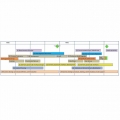7 Key Elements of Successful Business Readiness
A project “go-live” is usually eagerly anticipated. Often the culmination of months of preparation enables exciting opportunities for the business and its customers. It is key that this transition goes smoothly as it can have a bearing on the perception of the entire new capability and the worthiness of the business change.
Article by James Open.
It can be a risky time for an organisation, as when things do go significantly wrong the business impact could lead to adverse publicity and reputational damage. For example, there have been new Aircraft launched with significant engine and structural issues, Airports with baggage system and fire alarm issues and Banking websites and systems locking customers out of their accounts where the impact has been so extensive, they ended up reported in the news, which makes handling the issues all the more urgent and complex.
So in order to ensure the highest possible success for the change, careful business readiness should be planned. By understanding the potential impacts of the changes we can look to minimise them and to understand in advance what could go wrong to reduce the likelihood of occurrence and have mitigations in place.
There are a number of learnings from projects we have delivered, these make up the 7 key elements of business readiness which we describe next along with how each adds value.
1. Cross-functional Readiness Group
Many business leads and project representatives focus on getting their department ready, whether that is for a new product or way of working. Forming a cross-functional readiness layer to the project can add focus on the key change event and provide a forum for colleagues to work together and understand and capture the impacts of actions taken by differing teams. This way plans can be drawn that ensure change in one function does not adversely impact another.
For a booking system change example, involvement of the call centre that handles issues and the on-site team that checks in customers can ensure the booking system change is delivered in a way the downstream processes can continue to function as well as help to put together more robust contingency plans.
2. Stress Testing and Contingency Planning
Once the preferred plan is formed, considering scenarios of what could go wrong enables the teams to plan mitigations and workarounds. At this stage it is useful to bring operational management in too and the eventual owners of the new service. You could run a Desktop Exercise, discussing regular operations in the new locations, adding in common scenarios and more complicated issues to understand how the plan stands up to external factors.
For a terminal move, for example, it is important to consider the impacts on if customers go to the wrong terminal:
- How can the customers quickly get to the correct location? (Dedicated transport? Floorwalkers to guide?)
- How could customers end up in the wrong location? (Past experience, incorrect signage, old paperwork)
- What policies and exceptions can be put in place to support? (Late check-in closure for example)
- How will colleagues and other airport workers be communicated to on the situation?
You can then consider mitigation strategies to resolve the situation
- Communication to all customers (email, SMS, Calls, booking updates)
- Updates to transportation suppliers (Road signage, notifying local bus, rail, and taxi providers)
- Briefing and signage to on-site workers (Car park busses, information desks, visible presence)
Understanding the mitigation and resolution is a cyclical process that will build further granularity to the go-live plan.
3. Proving Trials and Early Go-Lives
Some change events may mean a shift to large volume operations overnight. The larger the number of users of services being changed the greater the impact if something was not to go to plan – some of the newsworthy examples cited previously where things have not gone to plan such as with aircraft unable to park in new locations (airbridges not reaching) Baggage system issues, staff access (physical and permissions) and login and access to IT and Banking Systems, highlight the importance and value of making sure things will go to plan.
An effective way to do this is for the project to run a series of trials which will also provide fuller assurance to senior management and familiarisation to colleagues. Continuing with the terminal move example, this could include:
Component trials
It is crucial to test infrastructure and processes in the new locations. The trials could take place with each element, with dummy flights created and staff playing the role of different customer types and requirements. Volumetric tests can also be completed. These trials can build up to ensure all components work together.
One of the key recommendations and learnings on previous go-lives has been to decouple as much as possible operationally from the go-live event.
For example, an airline could – whilst challenging, move a single route destination or a single flight to operate in the new location before the main go-live event. With careful management and observation, this can add huge value, as often airport and airline systems are difficult to fully replicate in a test scenario. Gratitude to customers in the form of vouchers and explaining why this is happening can gather valuable feedback for the main event. This is effectively a live trial and the bigger the change the more worthwhile live trials are. In addition, whilst in proving trials staff can do their best to act as customers, often their behaviour can’t reflect the reality of those totally unfamiliar with the new product, for example, wayfinding. Involving customers in proving trials or running live trials ensures the customer perspective is taken into consideration which can only make for a more successful go-live.
4. Business Continuity Planning
The trials should also look to test Business Continuity Plans that have been formed. Any change is likely to mean current business continuity plans will not do the job. By nature, business continuity events are unpredictable and as remote as it may seem, there is always a chance a business continuity event could take place at go-live or soon after. Having updated, trialed and tested Business Continuity in place ahead of go-live can ensure such eventualities can be treated as business as usual. Continuing with the terminal example, weather events can or other random events can impact the live operation. Ensuring the go-live team is unaffected by events is one part of what needs to be planned. The other is to ensure there are processes in place for live issue management, issuing of Hotel and coach transportation, initiating queue management, manual workarounds, etc.
It is important to consider offsite stakeholders too, such as contact centres who could field customer queries. You could work with the customer service centre to check their runbook script is updated and they are briefed on the trial too and ensure there is the ability to increase call centre capacity. Having taken this approach an operational go-live we executed in the midst of a snowstorm went so smoothly it was not noticed, which in the case of go-lives this is important. And there was no question of delaying go-live as even 1-day delay would have cost the business over £1m.
5. Go/No Go Checklists and Stage gates
Being ready for a go-live is important, and there are often many actions and resources needed. Forming checklists to gather all these items to confirm they are in place for the go-live is a simple way of making sure all the pre-requisites for a go-live are in place ahead of the event. This is particularly valuable where there is a repeatable change to be completed (for example upgrading IT equipment at multiple locations) as this can be turned into a repeatable process. This could include:
- People – Engineers remote technicians, local teams,
- Permissions – Local authority clearances, passes, change approvals
- Shipment of resources – Courier pickup, Customs clearances, local storage
- On-the-day Resources – ladders, trollies, tools, cables
- Communications – key phone numbers, Technical bridge
- User Testing – Checks with users they can work with the new equipment and perform their role.
- Fallbacks and contingency – what plans are in place to support
By building a simple, single presentable list (whether in excel or a PowerPoint slide) it is straightforward to track progress to the go-live event and escalate where there is a delay. This significantly reduces risk and concentrates attention and focus as we get closer to the actual event. It also provides timely visibility where a show-stopper is about to occur enabling resolution, mitigation or rescheduling (perhaps without penalty).
straightforward to track progress to the go-live event and escalate where there is a delay. This significantly reduces risk and concentrates attention and focus as we get closer to the actual event. It also provides timely visibility where a show-stopper is about to occur enabling resolution, mitigation or rescheduling (perhaps without penalty).
Developing this template and method for implementation can allow for scalability. As an added bonus, in a number of projects we have been able to use this project method to support the resolution of operational Business as Usual issues quickly.
6. Pre Go-live Training and Communications
Depending on what is changing, there could be a need for training colleagues and informing them of the upcoming changes. Scheduling training with subject experts, either locally or online and remotely in the weeks coming up to the change event enables time to cover those unable to attend. It also fully briefs the teams on the new way of working.
Communications should be clearly tailored and concise.
- What is changing and high-level reason
- What the project needs from you
- Determine level of support in place
- When is the impact of the change
- How long may there be an outage for – and what workarounds can be put in place
- Key contacts for any escalations
Supporting materials such as video recording of the training and documentation are important. However, hands-on practice with the new tool or location is also key.
7. The Go-live Day (or often night)
There are a number of tactics that can assist on go-live day:
- Creating an hour-by-hour plan or run book for the go-live event, which can be fully tracked
- Communications – Radio, mobile phone groups (eg Microsoft Teams/WhatsApp, CCTV live feeds,
- Observers – project and operational staff on hand to support and report back any issues
- Floorwalkers – clearly visible teams in tabards to assist colleagues and customers
- Remote support – helplines and help chats
- Form a command and control “Hub” with a named representative for business areas and suppliers to quicky address and if needed to escalate any issues
- Meeting cadence – for example, 2 hourly progress updates and status for each area
- Escalation Processes – quick escalation framework – or as we have called it “if in doubt, shout”. Set agreed standards – for example, if your forecast implementation delay could be over 30min escalate (or “shout”). Early visibility gives the opportunity to manage dependencies.
The result of following these 7 key elements in readiness for a go-live is a higher likelihood of a smooth (an uneventful) change that ensures the intended outcomes are achieved, the benefits realised and importantly, reputation remains intact. For more information on how to deliver fast effective change contact Acceler8 Consultancy.








